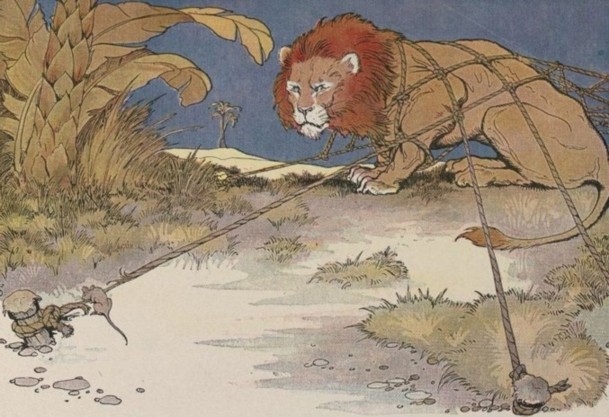PART A_1
Let’s learn vocabulary. Listen and repeat the words and the sentences with your tutor.
PART A_2
| 1. paw | /paw/ |
| -the foot of an animal having claws. | |
| With so much curiosity, the kitten nudged the ball of yarn with its claws. | |
| 2. timid | /TIM-id/ |
| -lacking in self-assurance, courage, or bravery; easily alarmed; timorous; shy. | |
| A timid girl entered the classroom and nervously introduced herself as a new student, | |
| 3. fright | /frahyt/ |
| -sudden and extreme fear; a sudden terror. | |
| He joined a drama club in order to overcome his stage fright. | |
| 4. nap | /nap/ |
| -to sleep for a short time; doze. | |
| Children hate taking a nap in the afternoon. | |
| 5. beg | /beg/ |
| -to ask for as a gift, as charity, or as a favor: | |
| The team leader was desperate to win, so she begged an expert to join the team. |
PART B_1
Let’s read the story. Please read it aloud, and I will check your pronunciation and intonation.
PART B_2
THE LION AND THE MOUSE

A Lion lay asleep in the forest, his great head resting on his paws. A timid little Mouse came upon him unexpectedly, and in her fright and haste to get away, ran across the Lion’s nose. Roused from his nap, the Lion laid his huge paw angrily on the tiny creature to kill her.
“Spare me!” begged the poor Mouse. “Please let me go and someday I will surely repay you.”
The Lion was much amused to think that a Mouse could ever help him. But he was generous and finally let the Mouse go.
Some days later, while stalking his prey in the forest, the Lion was caught in the toils of a hunter’s net. Unable to free himself, he filled the forest with his angry roaring. The Mouse knew the voice and quickly found the Lion struggling in the net. Running to one of the great ropes that bound him, she gnawed it until it parted, and soon the Lion was free.
“You laughed when I said I would repay you”, said the Mouse. “Now you see that even a Mouse can help a Lion.”
A kindness is never wasted.
PART C_1
Let’s answer comprehension questions. Please answer them based on the story.
PART C_2
| 1. | What happened while the Lion was asleep? |
| 2. | How did the Lion react when the Mouse disturbed his sleep? |
| 3. | How did the Mouse repay the Lion? |
PART D_1
Let’s discuss the story. Please answer the questions below and express your opinions.
PART D_2
| 1. | How would you describe the characteristics of the Mouse? |
| 2. | How would you describe the characteristics of the Lion? |
| 3. | If you were the Lion, would you let the Mouse go? |
| 4. | The fable’s lesson is “A kindness is never wasted.” Do you agree with this? Why or why not? |
| 5. | What do you make of those who take advantage of kind people? |
REVIEW AND FEEDBACK
Now, let us review the things that you learned in this lesson.
ではこのレッスンで学んだことを振り返りましょう。
(Please give a short feedback on how your student did on your class.)
| Grammar 文法 |
Pronunciation 発音 | Vocabulary 単語 |
Comprehension 理解 |
|
|---|---|---|---|---|
 GOOD GOOD |
文法の誤りはほとんどなく、完全な文章で話すことができる | ほとんどの単語をはっきりと正しく発音することができる | 習った表現を適切に使うことができる | 文章を理解し、質問に正しく答えることができる |
 FAIR |
文法の誤りはあるが、完全な文章で話すことができる | 発音の練習が必要な言葉がいくつかある | たまにミスはあるが、習った表現を適切に使うことができる | 文章を完全に理解するのは難しく、質問に正しく答えられないときもある |
 POOR |
文章で話すのは難しく、単語だけで話すことができる | 発音の練習が必要である | 習った単語と表現を少しだけ使うことができる | 文章を理解するのは難しく、質問に答えるのは難しい |
Parts of this lesson material are based on:
An eBook from The Project Gutenberg.
This eBook is for the use of anyone anywhere at no cost and with almost no restrictions whatsoever. You may copy it, give it away or re-use it under the terms of the Project Gutenberg License included with this eBook or online at www.gutenberg.org
An eBook from The Project Gutenberg.
This eBook is for the use of anyone anywhere at no cost and with almost no restrictions whatsoever. You may copy it, give it away or re-use it under the terms of the Project Gutenberg License included with this eBook or online at www.gutenberg.org